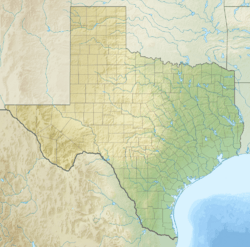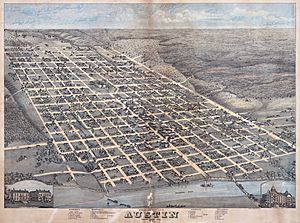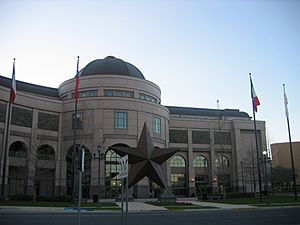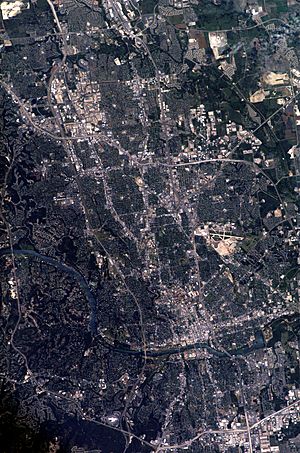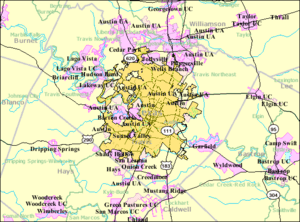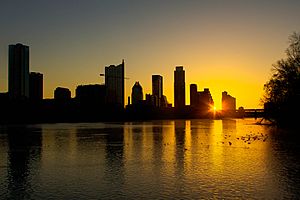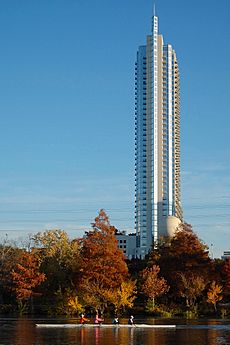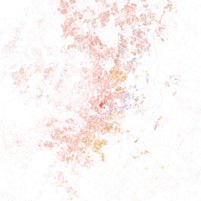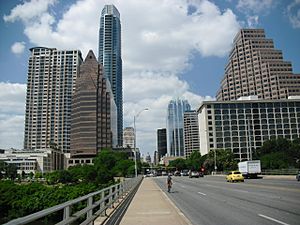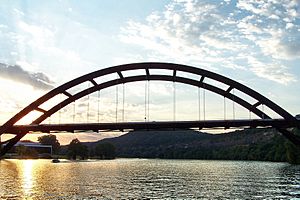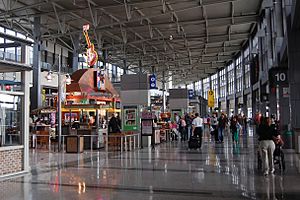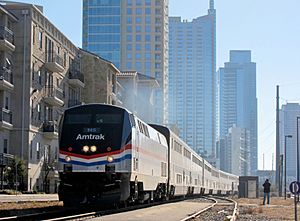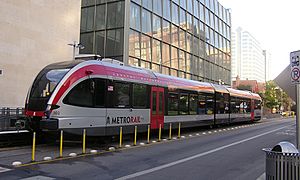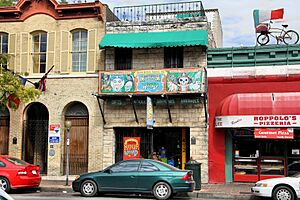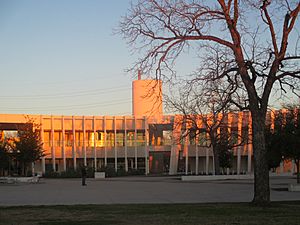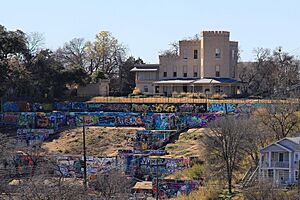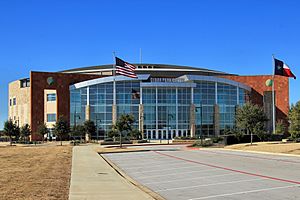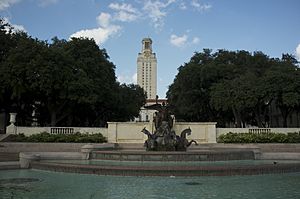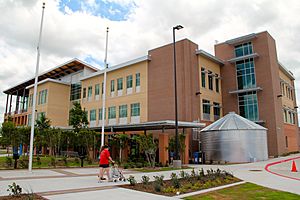Austin, Texas facts for kids
Quick facts for kids
Austin
|
|||||
|---|---|---|---|---|---|
|
Downtown Austin skyline
Congress Avenue Bridge
Darrell K Royal–Texas Memorial Stadium
Main Building at the University of Texas at Austin
Paramount Theatre
|
|||||
|
|||||
| Nicknames:
Live Music Capital of the World, Silicon Hills, ATX, City of the Violet Crown
|
|||||
| Motto(s):
Keep Austin Weird (unofficial)
|
|||||
| Country | |||||
| State | |||||
| Counties | Travis, Hays, Williamson | ||||
| Settled | 1835 | ||||
| Incorporated | December 27, 1839 | ||||
| Named for | Stephen F. Austin | ||||
| Government | |||||
| • Type | Council–manager | ||||
| Area | |||||
| • State capital | 326.51 sq mi (845.66 km2) | ||||
| • Land | 319.94 sq mi (828.64 km2) | ||||
| • Water | 6.57 sq mi (17.02 km2) | ||||
| • Metro | 4,285.70 sq mi (11,099.91 km2) | ||||
| Elevation | 607 ft (185 m) | ||||
| Population
(2022)U.S. Census Estimates
|
|||||
| • State capital | 974,447 |
||||
| • Rank | 33rd in North America 11th in the United States 4th in Texas |
||||
| • Density | 3,006.36/sq mi (1,160.76/km2) | ||||
| • Urban | 1,809,888 (US: 29th) | ||||
| • Urban density | 2,921.0/sq mi (1,127.8/km2) | ||||
| • Metro | 2,473,275 (US: 26th) | ||||
| Demonym(s) | Austinite | ||||
| GDP | |||||
| • Metro | 2.054 billion (2022) | ||||
| Time zone | UTC−6 (CST) | ||||
| • Summer (DST) | UTC−5 (CDT) | ||||
| ZIP Codes |
73301, 73344, 78681, 78701–78705, 78708–78739, 78741–78742, 78744–78768, 78772–78774, 78778–78779, 78783, 78799
|
||||
| Area codes | 512 & 737 | ||||
| FIPS code | 48-05000 | ||||
| GNIS feature ID | 2409761 | ||||
Austin (![]() i/ˈɔːstɪn/ AW-stin) is the capital of the U.S. state of Texas and the county seat and most populous city of Travis County, with portions extending into Hays and Williamson counties. Incorporated on December 27, 1839, it is the 26th-largest metropolitan area in the United States, the 11th-most populous city in the United States, the fifth-most populous city in the state after Houston, San Antonio, Dallas, and Fort Worth, and the second-most populous state capital city after Phoenix, the capital of Arizona. It has been one of the fastest growing large cities in the United States since 2010. Downtown Austin and Downtown San Antonio are approximately 80 miles (129 km) apart, and both fall along the Interstate 35 corridor. This combined metropolitan region of San Antonio–Austin has approximately 5 million people. Austin is the southernmost state capital in the contiguous United States and is considered a Gamma + level global city as categorized by the Globalization and World Cities Research Network.
i/ˈɔːstɪn/ AW-stin) is the capital of the U.S. state of Texas and the county seat and most populous city of Travis County, with portions extending into Hays and Williamson counties. Incorporated on December 27, 1839, it is the 26th-largest metropolitan area in the United States, the 11th-most populous city in the United States, the fifth-most populous city in the state after Houston, San Antonio, Dallas, and Fort Worth, and the second-most populous state capital city after Phoenix, the capital of Arizona. It has been one of the fastest growing large cities in the United States since 2010. Downtown Austin and Downtown San Antonio are approximately 80 miles (129 km) apart, and both fall along the Interstate 35 corridor. This combined metropolitan region of San Antonio–Austin has approximately 5 million people. Austin is the southernmost state capital in the contiguous United States and is considered a Gamma + level global city as categorized by the Globalization and World Cities Research Network.
As of 2024, Austin had an estimated population of 984,567, up from 961,855 at the 2020 census. The city is the cultural and economic center of the Austin–Round Rock metropolitan statistical area, which had an estimated population of 2,473,275 as of July 1, 2023. Located in Central Texas within the greater Texas Hill Country, it is home to numerous lakes, rivers, and waterways, including Lady Bird Lake and Lake Travis on the Colorado River, Barton Springs, McKinney Falls, and Lake Walter E. Long.
Residents of Austin are known as Austinites. They include a diverse mix of government employees, college students, musicians, high-tech workers, and blue-collar workers. The city's official slogan promotes Austin as "The Live Music Capital of the World", a reference to the city's many musicians and live music venues, as well as the long-running PBS TV concert series Austin City Limits. Austin is the site of South by Southwest (SXSW), an annual conglomeration of parallel film, interactive media, and music festivals. The city also adopted "Silicon Hills" as a nickname in the 1990s due to a rapid influx of technology and development companies. In recent years, some Austinites have adopted the unofficial slogan "Keep Austin Weird", which refers to the desire to protect small, unique, and local businesses from being overrun by large corporations. Since the late 19th century, Austin has also been known as the "City of the Violet Crown", because of the colorful glow of light across the hills just after sunset.
Emerging from a strong economic focus on government and education, since the 1990s, Austin has become a center for technology and business. The technology roots in Austin can be traced back to the 1960s, when defense electronics contractor Tracor (now BAE Systems) began operations in the city in 1962. IBM followed in 1967, opening a facility to produce its Selectric typewriters. Texas Instruments was set up in Austin two years later, and Motorola (now NXP Semiconductors) started semiconductor chip manufacturing in 1974. A number of Fortune 500 companies have headquarters or regional offices in Austin, including 3M, Advanced Micro Devices (AMD), Agilent Technologies, Amazon, Apple, Dell, Facebook (Meta), General Motors, Google, IBM, Intel, NXP Semiconductors, Oracle, Tesla, and Texas Instruments. With regard to education, Austin is the home of the University of Texas at Austin, one of the largest universities in the U.S., with over 50,000 students. In 2021, Austin became home to the Austin FC, the first (and currently only) major professional sports team in the city.
Contents
History
Austin, Travis County and Williamson County have been the site of human habitation since at least 9200 BC. The area's earliest known inhabitants lived during the late Pleistocene (Ice Age) and are linked to the Clovis culture around 9200 BC (11,200 years ago), based on evidence found throughout the area and documented at the much-studied Gault Site, midway between Georgetown and Fort Hood.
When settlers arrived from Europe, the Tonkawa tribe inhabited the area. The Comanches and Lipan Apaches were also known to travel through the area. Spanish colonists, including the Espinosa-Olivares-Aguirre expedition, traveled through the area for centuries, though few permanent settlements were created for some time. In 1730, three missions from East Texas were combined and reestablished as one mission on the south side of the Colorado River, in what is now Zilker Park, in Austin. The mission was in this area for only about seven months, and then was moved to San Antonio de Béxar and split into three missions. In the mid-18th century, the San Xavier missions were along the Colorado River, in what is now western Milam County, to facilitate exploration.
Early in the 19th century, Spanish forts were established in what are now Bastrop and San Marcos. Following Mexico's independence, new settlements were established in Central Texas, but growth in the region was stagnant because of conflicts with the regional Native Americans.
In 1835–1836, Texans fought and won independence from Mexico. Texas thus became an independent country with its own president, congress, and monetary system. After Vice President Mirabeau B. Lamar visited the area during a buffalo-hunting expedition between 1837 and 1838, he proposed that the republic's capital, then in Houston, be relocated to the area situated on the north bank of the Colorado River near the present-day Congress Avenue Bridge. In 1839, the Texas Congress formed a commission to seek a site for a new capital to be named for Stephen F. Austin. Mirabeau B. Lamar, second president of the newly formed Republic of Texas, advised the commissioners to investigate the area named Waterloo, noting the area's hills, waterways, and pleasant surroundings. Waterloo was selected and the name Austin was chosen as the town's new name. The location was seen as a convenient crossroads for trade routes between Santa Fe and Galveston Bay, as well as routes between northern Mexico and the Red River.
Edwin Waller was picked by Lamar to survey the village and draft a plan laying out the new capital. The original site was narrowed to 640 acres (259 ha) that fronted the Colorado River between two creeks, Shoal Creek and Waller Creek, which was later named in his honor. The 14-block grid plan was bisected by a broad north-south thoroughfare, Congress Avenue, running up from the river to Capital Square, where the new Texas State Capitol was to be constructed. A temporary one-story capitol was erected on the corner of Colorado and 8th Streets. On August 1, 1839, the first auction of 217 out of 306 lots total was held. The grid plan Waller designed and surveyed now forms the basis of downtown Austin.
In 1840, a series of conflicts between the Texas Rangers and the Comanches, known as the Council House Fight and the Battle of Plum Creek, finally pushed the Comanches westward, mostly ending conflicts in Central Texas. Settlement in the area began to expand quickly. Travis County was established in 1840, and the surrounding counties were mostly established within the next two decades.
Initially, the new capital thrived. But Lamar's political enemy, Sam Houston, used two Mexican army incursions to San Antonio as an excuse to move the government. Sam Houston fought bitterly against Lamar's decision to establish the capital in such a remote wilderness. The men and women who traveled mainly from Houston to conduct government business were intensely disappointed as well. By 1840, the population had risen to 856, of whom nearly half fled from Austin when Congress recessed. The resident Black population listed in January of this same year was 176. The fear of Austin's proximity to the Indians and Mexico, which still considered Texas a part of their land, created an immense motive for Sam Houston, the first and third President of the Republic of Texas, to relocate the capital once again in 1841. Upon threats of Mexican troops in Texas, Houston raided the Land Office to transfer all official documents to Houston for safe keeping in what was later known as the Archive War, but the people of Austin would not allow this unaccompanied decision to be executed. The documents stayed, but the capital would temporarily move from Austin to Houston to Washington-on-the-Brazos. Without the governmental body, Austin's population declined to a low of only a few hundred people throughout the early 1840s. The voting by the fourth President of the Republic, Anson Jones, and Congress, who reconvened in Austin in 1845, settled the issue to keep Austin the seat of government as well as annex the Republic of Texas into the United States.

In 1860, 38% of Travis County residents were slaves. In 1861, with the outbreak of the American Civil War, voters in Austin and other Central Texas communities voted against secession. However, as the war progressed and fears of attack by Union forces increased, Austin contributed hundreds of men to the Confederate forces. The African American population of Austin swelled dramatically after the enforcement of the Emancipation Proclamation in Texas by Union General Gordon Granger at Galveston in an event commemorated as Juneteenth. Black communities such as Wheatville, Pleasant Hill, and Clarksville were established with Clarksville being the oldest surviving freedomtown ‒ the original post-Civil War settlements founded by former African-American slaves ‒ west of the Mississippi River. In 1870, blacks made up 36.5% of Austin's population. The postwar period saw dramatic population and economic growth. The opening of the Houston and Texas Central Railway (H&TC) in 1871 turned Austin into the major trading center for the region with the ability to transport both cotton and cattle. The Missouri, Kansas, and Texas (MKT) line followed close behind. Austin was also the terminus of the southernmost leg of the Chisholm Trail and "drovers" pushed cattle north to the railroad. Cotton was one of the few crops produced locally for export and a cotton gin engine was located downtown near the trains for "ginning" cotton of its seeds and turning the product into bales for shipment. However, as other new railroads were built through the region in the 1870s, Austin began to lose its primacy in trade to the surrounding communities. In addition, the areas east of Austin took over cattle and cotton production from Austin, especially in towns like Hutto and Taylor that sit over the blackland prairie, with its deep, rich soils for producing cotton and hay.
In September 1881, Austin public schools held their first classes. The same year, Tillotson Collegiate and Normal Institute (now part of Huston-Tillotson University) opened its doors. The University of Texas at Austin held its first classes in 1883, although classes had been held in the original wooden state Capitol for four years before.
During the 1880s, Austin gained new prominence as the state capitol building was completed in 1888 and claimed as the seventh largest building in the world. In the late 19th century, Austin expanded its city limits to more than three times its former area, and the first granite dam was built on the Colorado River to power a new street car line and the new "moon towers". Unfortunately, the first dam washed away in a flood on April 7, 1900.
In the 1920s and 1930s, Austin launched a series of civic development and beautification projects that created much of the city's infrastructure and many of its parks. In addition, the state legislature established the Lower Colorado River Authority (LCRA) that, along with the city of Austin, created the system of dams along the Colorado River to form the Highland Lakes. These projects were enabled in large part because the Public Works Administration provided Austin with greater funding for municipal construction projects than other Texas cities.
During the early twentieth century, a three-way system of social segregation emerged in Austin, with Anglos, African Americans and Mexicans being separated by custom or law in most aspects of life, including housing, health care, and education. Many of the municipal improvement programs initiated during this period—such as the construction of new roads, schools, and hospitals—were deliberately designed to institutionalize this system of segregation. Racial segregation increased in Austin during the first half of the twentieth century, with African Americans and Mexicans experiencing high levels of discrimination and social marginalization.
In 1940, the destroyed granite dam on the Colorado River was finally replaced by a hollow concrete dam that formed Lake McDonald (now called Lake Austin) and which has withstood all floods since. In addition, the much larger Mansfield Dam was built by the LCRA upstream of Austin to form the flood-control lake, Lake Travis. In the early 20th century, the Texas Oil Boom took hold, creating tremendous economic opportunities in Southeast Texas and North Texas. The growth generated by this boom largely passed by Austin at first, with the city slipping from fourth largest to 10th largest in Texas between 1880 and 1920.
After the mid-20th century, Austin became established as one of Texas' major metropolitan centers. In 1970, the United States Census Bureau reported Austin's population as 14.5% Hispanic, 11.9% black, and 73.4% non-Hispanic white. In the late 20th century, Austin emerged as an important high tech center for semiconductors and software. The University of Texas at Austin emerged as a major university.
The 1970s saw Austin's emergence in the national music scene, with local artists such as Willie Nelson, Asleep at the Wheel, and Stevie Ray Vaughan and iconic music venues such as the Armadillo World Headquarters. Over time, the long-running television program Austin City Limits, its namesake Austin City Limits Festival, and the South by Southwest music festival solidified the city's place in the music industry.
Geography
The most southerly of the capitals of the contiguous forty-eight states, Austin is located in Central Texas, along the Balcones Escarpment and Interstate 35, 150 miles (240 kilometres) northwest of Houston. It is also 160 miles (260 kilometres) south of Dallas and 75 miles (121 kilometres) north of San Antonio. Its elevation varies from 425 feet (130 m) to approximately 1,000 feet (305 m) above sea level. In 2010, the city occupied a total area of 271.8 square miles (704 km2). Approximately 6.9 square miles (18 km2) of this area is water.
Austin is situated on the Colorado River, with three man-made (artificial) lakes within the city limits: Lady Bird Lake (formerly known as Town Lake), Lake Austin (both created by dams along the Colorado River), and Lake Walter E. Long that is partly used for cooling water for the Decker Power Plant. Mansfield Dam and the foot of Lake Travis are located within the city's limits. Lady Bird Lake, Lake Austin, and Lake Travis are each on the Colorado River. As a result of its straddling the Balcones Fault, much of the eastern part of the city is flat, with heavy clay and loam soils, whereas, the western part and western suburbs consist of rolling hills on the edge of the Texas Hill Country. Because the hills to the west are primarily limestone rock with a thin covering of topsoil, portions of the city are frequently subjected to flash floods from the runoff caused by thunderstorms. To help control this runoff and to generate hydroelectric power, the Lower Colorado River Authority operates a series of dams that form the Texas Highland Lakes. The lakes also provide venues for boating, swimming, and other forms of recreation within several parks on the lake shores.
Austin is located at the intersection of four major ecological regions, and is consequently a temperate-to-hot green oasis with a highly variable climate having some characteristics of the desert, the tropics, and a wetter climate. The area is very diverse ecologically and biologically, and is home to a variety of animals and plants. Notably, the area is home to many types of wildflowers that blossom throughout the year but especially in the spring, including the popular bluebonnets, some planted in an effort by "Lady Bird" Johnson, wife of former President Lyndon Johnson.
A popular point of prominence in Austin is Mount Bonnell. At about 780 feet (238 m) above sea level, it is a natural limestone formation overlooking Lake Austin on the Colorado River, with an observation deck about 200 feet (61 m) below its summit.
The soils of Austin range from shallow, gravelly clay loams over limestone in the western outskirts to deep, fine sandy loams, silty clay loams, silty clays or clays in the city's eastern part. Some of the clays have pronounced shrink-swell properties and are difficult to work under most moisture conditions. Many of Austin's soils, especially the clay-rich types, are slightly to moderately alkaline and have free calcium carbonate.
Austin has several rock climbing locations. Rock climbing can be found at three Austin parks: Barton Creek Greenbelt, Bull Creek Park and McKinney Falls State Park. The sport-climbing routes at Barton Creek Greenbelt–with its many vertical to overhanging walls–offer challenges to both the beginner and advanced climber.
Cityscape
Austin's skyline historically was modest, dominated by the Texas State Capitol and the University of Texas Main Building (more commonly referred to as the "clock tower"). However, many new high-rise towers have been constructed since 2000 -- Austin's ten tallest buildings were completed after 2003. The city's tallest building, The Austonian, was topped out on September 17, 2009. Austin is currently undergoing a skyscraper boom, which includes recent construction on the now complete 360 Condominiums at 563 feet (172 m), Spring (condominiums), the Austonian at 683 feet (208 m), and several other office, hotel and residential buildings. Downtown's buildings are somewhat spread out, partly due to a restriction that preserves the view of the Texas State Capitol from various locations around Austin (known as the Capitol View Corridors).
At night, parts of Austin are lit by "artificial moonlight" from Moonlight Towers built to illuminate the central part of the city. The 165-foot (50 m) moonlight towers were built in the late 19th century and are now recognized as historic landmarks. Only 15 of the 31 original innovative towers remain standing in Austin, and none remain in any of the other cities where they were installed. The towers are featured in the 1993 film Dazed and Confused.
Downtown
The central business district of Austin is home to the tallest condo towers in the state, with the under construction Independent (58 stories and 690 feet (210 metres). tall) and The Austonian (topping out at 56 floors and 685 feet (209 metres). tall). The Independent will supplant The Austonian as the tallest all-residential building in the U.S. west of the Mississippi River when completed in 2018.
In 2005, then-Mayor Will Wynn set out a goal of having 25,000 people living Downtown by 2015. Although Downtown's growth did not meet this goal, Downtown's residential population did surge from an estimated 5,000 in 2005 to 12,000 in 2015. The skyline has drastically changed in recent years, and the residential real estate market has remained relatively strong. As of December 2016, there are 31 high-rise projects either under construction, approved or planned to be completed in Austin's downtown core between 2017 and 2020. Sixteen of those are set to rise above 400 feet (120 metres). tall, including four above 600', and eight above 500'. An additional 15 towers are slated to stand between 300' and 399' tall.
Downtown growth has been aided by the presence of a popular live music and nightlife scene, museums, restaurants, and Lady Bird Lake, considered one of the city's best recreational spots. The 2nd Street District consists of several new residential projects, restaurants, upscale boutiques and other entertainment venues, as well as Austin's City Hall. Across 2nd Street from Austin's City Hall is the new ACL Live @ the Moody Theatre where the long-running PBS program Austin City Limits, is filmed. It is located at the base of the new 478 feet (146 m) W Hotel. The South by Southwest is a music, film and interactive festival which occurs over five days each March in downtown Austin, and includes one of the world's largest music festivals; with more than 3,000 acts playing in more than 100 venues.
Climate
| Weather chart for Austin | |||||||||||||||||||||||||||||||||||||||||||||||
|---|---|---|---|---|---|---|---|---|---|---|---|---|---|---|---|---|---|---|---|---|---|---|---|---|---|---|---|---|---|---|---|---|---|---|---|---|---|---|---|---|---|---|---|---|---|---|---|
| J | F | M | A | M | J | J | A | S | O | N | D | ||||||||||||||||||||||||||||||||||||
|
2.2
62
41
|
2
65
45
|
2.8
72
51
|
2.1
80
59
|
4.4
86
67
|
4.3
92
72
|
1.9
95
74
|
2.4
97
75
|
3
91
70
|
3.9
82
61
|
3
71
51
|
2.4
63
42
|
||||||||||||||||||||||||||||||||||||
| temperatures in °F precipitation totals in inches |
|||||||||||||||||||||||||||||||||||||||||||||||
|
Metric conversion
|
|||||||||||||||||||||||||||||||||||||||||||||||
Under the Köppen climate classification, Austin has a humid subtropical climate. This climate is typified by very long, hot summers; warm transitional seasons; and short, mild winters. Austin averages 34.32 inches (872 mm) of annual rainfall and it is distributed mostly evenly throughout the year, though May and June are generally the wettest months. Sunshine is abundant during all seasons, with nearly 2,650 hours, or 60.3% of the possible total, of bright sunshine per year.
Summers in Austin are very hot. Average July and August highs frequently reach the high-90s °F (34–36 °C), and triple digits are common. Highs reach 90 °F (32 °C) on 116 days per year, and 100 °F (38 °C) on 18 days per year. The highest ever recorded temperature was 112 °F (44 °C) occurring on September 5, 2000, and August 28, 2011. Summer humidity is inconsistent and is highly dependent on the shifting patterns of air flow and wind direction. Humidity rises when the air drifts inland from the Gulf of Mexico, but decreases significantly when the air is channeled through the Chihuahuan Desert of West Texas.
Winters in Austin are mild. Daytime highs in December and January average 63 °F (17 °C) and 62 °F (17 °C), respectively, and the overnight low reaches or exceeds freezing only 19 times per year. The temperature falls below 45 °F (7 °C) during 88 evenings per year, including most nights between mid-December and mid-February. The lowest ever recorded temperature was −2 °F (−19 °C) on January 31, 1949. Roughly every two years Austin experiences an ice storm that freezes roads over and cripples travel in the city for 24 to 48 hours. When Austin received 0.04 inches (1 mm) of ice on January 24, 2014, there were 278 vehicular collisions. Similarly, snowfall is exceptionally rare in Austin. A snow event of 0.9 inches (2 cm) on February 4, 2011, caused more than 300 car crashes. A 13-inch (33 cm) snowstorm brought the city to a near standstill in 1985.
| Climate data for Camp Mabry, Austin, Texas (1981–2010 normals, extremes 1891–present) | |||||||||||||
|---|---|---|---|---|---|---|---|---|---|---|---|---|---|
| Month | Jan | Feb | Mar | Apr | May | Jun | Jul | Aug | Sep | Oct | Nov | Dec | Year |
| Record high °F (°C) | 90 (32) |
99 (37) |
98 (37) |
99 (37) |
104 (40) |
109 (43) |
109 (43) |
112 (44) |
112 (44) |
100 (38) |
91 (33) |
90 (32) |
112 (44) |
| Mean maximum °F (°C) | 79.3 (26.3) |
83.3 (28.5) |
86.6 (30.3) |
91.7 (33.2) |
95.4 (35.2) |
98.1 (36.7) |
101.0 (38.3) |
102.9 (39.4) |
99.1 (37.3) |
93.3 (34.1) |
84.8 (29.3) |
79.7 (26.5) |
103.9 (39.9) |
| Mean daily maximum °F (°C) | 61.5 (16.4) |
65.2 (18.4) |
72.2 (22.3) |
79.8 (26.6) |
86.5 (30.3) |
92.1 (33.4) |
95.6 (35.3) |
97.0 (36.1) |
90.5 (32.5) |
81.8 (27.7) |
71.4 (21.9) |
62.7 (17.1) |
79.7 (26.5) |
| Mean daily minimum °F (°C) | 41.5 (5.3) |
44.8 (7.1) |
51.3 (10.7) |
58.6 (14.8) |
66.7 (19.3) |
72.3 (22.4) |
74.4 (23.6) |
74.6 (23.7) |
69.4 (20.8) |
60.6 (15.9) |
50.6 (10.3) |
42.3 (5.7) |
58.9 (14.9) |
| Mean minimum °F (°C) | 26.7 (−2.9) |
28.5 (−1.9) |
34.7 (1.5) |
42.9 (6.1) |
54.1 (12.3) |
64.2 (17.9) |
69.9 (21.1) |
69.0 (20.6) |
56.9 (13.8) |
44.7 (7.1) |
34.6 (1.4) |
26.7 (−2.9) |
22.0 (−5.6) |
| Record low °F (°C) | −2 (−19) |
−1 (−18) |
18 (−8) |
30 (−1) |
40 (4) |
51 (11) |
57 (14) |
58 (14) |
41 (5) |
30 (−1) |
20 (−7) |
4 (−16) |
−2 (−19) |
| Average precipitation inches (mm) | 2.22 (56) |
2.02 (51) |
2.76 (70) |
2.09 (53) |
4.44 (113) |
4.33 (110) |
1.88 (48) |
2.35 (60) |
2.99 (76) |
3.88 (99) |
2.96 (75) |
2.40 (61) |
34.32 (872) |
| Average snowfall inches (cm) | 0.4 (1.0) |
0.2 (0.51) |
0 (0) |
0 (0) |
0 (0) |
0 (0) |
0 (0) |
0 (0) |
0 (0) |
0 (0) |
0 (0) |
trace | 0.6 (1.5) |
| Average precipitation days (≥ 0.01 in) | 7.4 | 7.4 | 9.2 | 7.1 | 8.9 | 7.7 | 5.4 | 4.9 | 6.7 | 7.5 | 7.5 | 7.8 | 87.5 |
| Average snowy days (≥ 0.1 in) | 0.3 | 0.2 | 0 | 0 | 0 | 0 | 0 | 0 | 0 | 0 | 0 | 0 | 0.5 |
| Average relative humidity (%) | 67.2 | 66.0 | 64.2 | 66.4 | 71.4 | 69.5 | 65.1 | 63.8 | 68.4 | 67.1 | 68.7 | 67.6 | 67.1 |
| Mean monthly sunshine hours | 163.8 | 169.3 | 205.9 | 205.8 | 227.1 | 285.5 | 317.2 | 297.9 | 233.8 | 215.6 | 168.3 | 153.5 | 2,643.7 |
| Percent possible sunshine | 51 | 54 | 55 | 53 | 54 | 68 | 74 | 73 | 63 | 61 | 53 | 48 | 60 |
| Source: NOAA (relative humidity and sun 1961–1990) , Weather.com | |||||||||||||
2011 drought
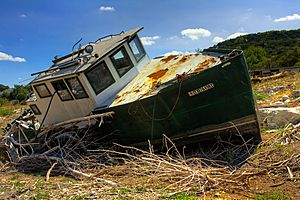
From October 2010 through September 2011, both major reporting stations in Austin, Camp Mabry and Bergstrom Int'l, had the least rainfall of a water year on record, receiving less than a third of normal precipitation. This was a result of La Niña conditions in the eastern Pacific Ocean where water was significantly cooler than normal. David Brown, a regional official with the National Oceanic and Atmospheric Administration, has explained that "these kinds of droughts will have effects that are even more extreme in the future, given a warming and drying regional climate."
Demographics
| Historical population | |||
|---|---|---|---|
| Census | Pop. | %± | |
| 1850 | 629 | — | |
| 1860 | 3,494 | 455.5% | |
| 1870 | 4,428 | 26.7% | |
| 1880 | 11,013 | 148.7% | |
| 1890 | 14,575 | 32.3% | |
| 1900 | 22,258 | 52.7% | |
| 1910 | 29,860 | 34.2% | |
| 1920 | 34,876 | 16.8% | |
| 1930 | 53,120 | 52.3% | |
| 1940 | 87,930 | 65.5% | |
| 1950 | 132,459 | 50.6% | |
| 1960 | 186,545 | 40.8% | |
| 1970 | 253,539 | 35.9% | |
| 1980 | 345,890 | 36.4% | |
| 1990 | 465,622 | 34.6% | |
| 2000 | 656,562 | 41.0% | |
| 2010 | 790,390 | 20.4% | |
| 2020 | 961,855 | 21.7% | |
| 2023 (est.) | 979,882 | 24.0% | |
| U.S. Decennial Census 2010–2020 |
|||
In 2020, there were 961,855 people, up from the 2000 United States census tabulation where there were 656,562 people, 265,649 households, and 141,590 families residing in the city. In 2000, the population density was 2,610 inhabitants per square mile (1,010/km2). There were 276,842 dwelling units at an average density of 1,101 per square mile (425/km2). There were 265,648 households, out of which 26.8% had children under the age of 18 living with them, 38.1% were married couples living together, 10.8% had a female householder with no husband present, and 46.7% were non-families. 32.8% of all households were made up of individuals, and 4.6% had someone living alone who was 65 years of age or older. The average household size was 2.40 and the average family size was 3.14.
In the city the population was spread out, with 22.5% of the population under the age of 18, 16.6% from 18 to 24, 37.1% from 25 to 44, 17.1% from 45 to 64, and 6.7% were 65 years of age or older. The median age was 30 years. For every 100 females, there were 105.8 males.
The median income for a household in the city was US$42,689, and the median income for a family was $54,091. Males had a median income of $35,545 compared to $30,046 for females. The per capita income for the city was $24,163. About 9.1% of families and 14.4% of the population were below the poverty line, including 16.5% of those under age 18 and 8.7% of those age 65 or over. The median house price was $185,906 in 2009, and it has increased every year since 2004. The median value of a house which the owner occupies was $318,400 in 2019—higher than the average American home value of $240,500.
Race and ethnicity
| Racial composition | 2020 | 2010 | 1990 | 1970 | 1950 |
|---|---|---|---|---|---|
| White (Non-Hispanic) | 47.1% | 48.7% | 61.7% | 73.4% | 86.6% |
| Hispanic or Latino | 32.5% | 35.1% | 23.0% | 14.5% | n/a |
| Asian | 8.9% | 6.2% | 3.0% | 0.2% | 0.1% |
| Black or African American | 6.9% | 7.7% | 12.4% | 11.8% | 13.3% |
| Mixed | 3.9% | 1.7% |
According to the 2010 United States census, the racial composition of Austin was 68.3% White (48.7% non-Hispanic whites), 35.1% Hispanic or Latino (29.1% Mexican, 0.5% Puerto Rican, 0.4% Cuban, 5.1% Other), 8.1% African American, 6.3% Asian (1.9% Indian, 1.5% Chinese, 1.0% Vietnamese, 0.7% Korean, 0.3% Filipino, 0.2% Japanese, 0.8% Other), 0.9% American Indian, 0.1% Native Hawaiian and Other Pacific Islander, and 3.4% two or more races.
According to the 2020 United States census, the racial composition of Austin was 72.6% White (48.3% non-Hispanic whites), 33.9% Hispanic or Latino , 7.8% African American, 7.6% Asian, 0.7% American Indian, 0.1% Native Hawaiian and Other Pacific Islander, and 3.4% two or more races.
A 2014 University of Texas study stated that Austin was the only U.S. city with a fast growth rate between 2000 and 2010 with a net loss in African Americans. As of 2014[update], Austin's African American and non-Hispanic white percentage share of the total population was declining despite the actual numbers of both ethnic groups increasing, as the rapid growth of the Latino or Hispanic and Asian populations has outpaced all other ethnic groups in the city. Austin's non-Hispanic white population first dropped below 50% in 2005.
Religion
According to Sperling's BestPlaces, 52.4% of Austin's population are religious. The majority of Austinites identified themselves as Christians, about 25.2% of whom claimed affiliation with the Catholic Church. The city's Catholic population is served by the Roman Catholic Diocese of Austin, headquartered at the Cathedral of Saint Mary. Nationwide, 23% of Americans identified as Catholic in 2016. Other significant Christian groups in Austin include Baptists (8.7%), followed by Methodists (4.3%), Latter-Day Saints (1.5%), Episcopalians or Anglicans (1.0%), Lutherans (0.8%), Presbyterians (0.6%), Pentecostals (0.3%), and other Christians such as the Disciples of Christ and Eastern Orthodox Church (7.1%). The second largest religion Austinites identify with is Islam (1.7%); roughly 0.8% of Americans nationwide claimed affiliation with the Islamic faith. The dominant branch of Islam is Sunni Islam. Established in 1977, the largest mosque in Austin is the Islamic Center of Greater Austin. The community is affiliated with the Islamic Society of North America. The same study says that eastern faiths including Buddhism, Sikhism, and Hinduism made up 0.9% of the city's religious population. Several Hindu temples exist in the Austin Metropolitan area with the most notable one being Radha Madhav Dham. Judaism forms less than 0.1% of the religious demographic in Austin. Orthodox, Reform, and Conservative congregations are present in the community. In addition to those religious groups, Austin is also home to an active secular humanist community, hosting nationwide television shows and charity work.
Homelessness
As of 2019, there were 2,255 individuals experiencing homelessness in Travis County. Of those, 1,169 were sheltered and 1,086 were unsheltered. In September 2019, the Austin City Council approved $62.7 million for programs aimed at homelessness, which includes housing displacement prevention, crisis mitigation, and affordable housing; the city council also earmarked $500,000 for crisis services and encampment cleanups.
In June 2019, following a federal court ruling on homelessness sleeping in public, the Austin City Council lifted a 25-year-old ban on camping, sitting, or lying down in public unless doing so causes an obstruction. The resolution also included the approval of a new housing-focused shelter in South Austin. In early October 2019, Texas Governor Greg Abbott sent a letter to Mayor Steve Adler threatening to deploy state resources to combat the camping ban repeal. On October 17, 2019, the City Council revised the camping ordinance, which imposed increased restrictions on sidewalk camping. In November 2019, the State of Texas opened a temporary homeless encampment on a former vehicle storage yard owned by the Texas Department of Transportation.
In May 2021, the camping ban was reinstated after a ballot proposition was approved by 57% of voters. The ban introduces penalties for camping, sitting, or lying down on a public sidewalk or sleeping outdoors in or near Downtown Austin or the area around the University of Texas campus. The ordinance would also prohibit solicitation at certain locations.
Economy
The Greater Austin metropolitan statistical area had a gross domestic product (GDP) of $222 billion in 2022. Austin is considered to be a major center for high tech. Thousands of graduates each year from the engineering and computer science programs at the University of Texas at Austin provide a steady source of employees that help to fuel Austin's technology and defense industry sectors. As a result of the high concentration of high-tech companies in the region, Austin was strongly affected by the dot-com boom in the late 1990s and subsequent bust. Austin's largest employers include the Austin Independent School District, the City of Austin, Dell Technologies, the U.S. Federal Government, NXP Semiconductors, IBM, St. David's Healthcare Partnership, Seton Family of Hospitals, the State of Texas, the Texas State University, and the University of Texas at Austin.
Other high-tech companies with operations in Austin include 3M, Apple (the largest campus outside of Cupertino), Amazon, AMD, Apartment Ratings, Applied Materials, Arm, Bigcommerce, BioWare, Blizzard Entertainment, Buffalo Technology, Cirrus Logic, Cisco Systems, Cloudflare, Crowdstrike, Dropbox, eBay, Electronic Arts, Flextronics, Facebook, Google, Hewlett-Packard, Hoover's, HomeAway, HostGator, Indeed, Intel Corporation, Meta, National Instruments, Nintendo, Nvidia, Oracle, PayPal, Polycom, Qualcomm, Rackspace, RetailMeNot, Rooster Teeth, Samsung Group, Silicon Labs, Spansion, TikTok, United Devices, VMware, X (formerly Twitter), Xerox, and Zoho Corporation. In 2010, Facebook accepted a grant to build a downtown office that could bring as many as 200 jobs to the city. The proliferation of technology companies has led to the region's nickname, "Silicon Hills", and spurred development that greatly expanded the city.
Tesla, Inc., an electric vehicle and clean energy company has its corporate headquarters in Austin inside Gigafactory Texas, a large vehicle assembly plant which employs over 20,000 people. The company expects to eventually have a staff of 60,000 in the Austin area as production ramps up.
Austin is also emerging as a hub for pharmaceutical and biotechnology companies; the city is home to about 85 of them. In 2004, the city was ranked by the Milken Institute as the No. 12 biotech and life science center in the United States and in 2018, CBRE Group ranked Austin as #3 emerging life sciences cluster. Companies such as Hospira, Pharmaceutical Product Development, and ArthroCare Corporation are located there.
Whole Foods Market, an international grocery store chain specializing in fresh and packaged food products, was founded and is headquartered in Austin.
Other companies based in Austin include NXP Semiconductors, GoodPop, Temple-Inland, Sweet Leaf Tea Company, Keller Williams Realty, National Western Life, GSD&M, Dimensional Fund Advisors, Golfsmith, Forestar Group, EZCorp, Outdoor Voices, Tito's Vodka, Speak Social, and YETI.
In 2018, Austin metro-area companies saw a total of $1.33 billion invested. In 2018, Austin's venture capital investments accounted for more than 60 percent of Texas' total investments.
Top employers
According to Austin's comprehensive annual financial reports, the top employers by number of employees in the county are the following. "NR" indicates the employer was not ranked among the top ten employers that year.
| Employer | Employees (2022) |
Employees (2013) |
Employees (2004) |
Employees (1998) |
|---|---|---|---|---|
| Government of Texas | 39,306 | 36,948 | NR | NR |
| University of Texas at Austin | 29,597 | 24,183 | 21,000 | 20,342 |
| H-E-B | 20,749 | 11,277 | NR | NR |
| City of Austin | 15,548 | 12,372 | 10,617 | 10,606 |
| Federal government of the United States | 15,000 | 10,500 | 10,200 | NR |
| Dell Technologies | 13,000 | 14,000 | 16,500 | 10,700 |
| Ascension Seton | 12,086 | 12,609 | 6,393 | NR |
| Amazon.com | 11,000 | NR | NR | NR |
| St. David's Healthcare Partnership | 10,854 | 7,950 | 5,000 | NR |
| Austin Independent School District | 10,565 | 11,465 | 10,714 | 9,159 |
| IBM | NR | 6,000 | 6,200 | 7,000 |
| Freescale Semiconductor | NR | NR | 6,500 | NR |
| Texas State University | NR | NR | 5,103 | NR |
| Motorola | NR | NR | NR | 10,000 |
| Internal Revenue Service | NR | NR | NR | 5,700 |
| Texas Department of Health | NR | NR | NR | 5,634 |
| Advanced Micro Devices | NR | NR | NR | 4,200 |
| Texas Department of Public Safety | NR | NR | NR | 4,000 |
Transportation
In 2009, 72.7% of Austin (city) commuters drove alone, with other mode shares being: 10.4% carpool, 6% were remote workers, 5% use transit, 2.3% walk, and 1% bicycle. In 2016, the American Community Survey estimated modal shares for Austin (city) commuters of 73.5% for driving alone, 9.6% for carpooling, 3.6% for riding transit, 2% for walking, and 1.5% for cycling. The city of Austin has a lower than average percentage of households without a car. In 2015, 6.9 percent of Austin households lacked a car, and decreased slightly to 6 percent in 2016. The national average was 8.7 percent in 2016. Austin averaged 1.65 cars per household in 2016, compared to a national average of 1.8.
In mid-2019, TomTom ranked Austin as having the worst traffic congestion in Texas, as well as 19th nationally and 179th globally.
Highways
Central Austin lies between two major north–south freeways: I-35 to the east and the Mopac Expressway (Loop 1) to the west. US 183 runs from northwest to southeast, and SH 71 crosses the southern part of the city from east to west, completing a rough "box" around central and north-central Austin. Austin is the largest city in the United States to be served by only one Interstate Highway.
US 290 enters Austin from the east and merges into I-35. Its highway designation continues south on I-35 and then becomes part of SH 71, continuing to the west. Highway 290 splits from Highway 71 in southwest Austin, in an interchange known as "The Y." SH 71 continues to Brady, Texas, and Highway 290 continues west to intersect I-10 near Junction. Interstate 35 continues south through San Antonio to Laredo on the Texas-Mexico border. Interstate 35 is the highway link to the Dallas-Fort Worth metroplex in Northern Texas. There are two links to Houston (US 290 and SH 71/I-10). US 183 leads northwest of Austin toward Lampasas.
In the mid-1980s, construction was completed on Loop 360, a scenic highway that curves through the hill country from near the 71/Mopac interchange in the south to near the US 183/Mopac interchange in the north. The iconic Pennybacker Bridge, also known as the "360 Bridge," crosses Lake Austin to connect the northern and southern portions of Loop 360.
Tollways
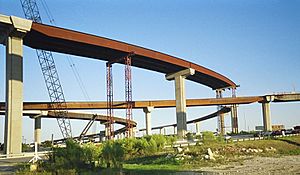
SH 130 is a bypass route designed to relieve traffic congestion, starting from Interstate 35 just north of Georgetown and running along a parallel route to the east, where it bypasses Round Rock, Austin, San Marcos and New Braunfels before ending at I-10 east of Seguin, where drivers could drive 30 miles (48 km) west to return to I-35 in San Antonio. The first segment was opened in November 2006, which was located east of Austin–Bergstrom International Airport at Austin's southeast corner on SH 71. Highway 130 runs concurrently with SH 45 from Pflugerville on the north until it reaches US 183 well south of Austin, at which point SR 45 continues west. The entire route of SH 130 is now complete. The final leg opened on November 1, 2012. The highway is noted for having a maximum speed limit of 85 mph (137 km/h) for the entire route. The 41-mile (66 km) section of the toll road between Mustang Ridge and Seguin has a posted speed limit of 85 mph (137 km/h), the highest posted speed limit in the United States.
SH 45 runs east–west from just south of US 183 in Cedar Park to 130 inside Pflugerville (just east of Round Rock). A tolled extension of State Highway Loop 1 was also created. A new southeast leg of SH 45 has recently been completed, running from US 183 and the south end of Segment 5 of TX-130 south of Austin due west to I-35 at the FM 1327/Creedmoor Road exit between the south end of Austin and Buda. The 183A Toll Road opened in March 2007, providing a tolled alternative to US 183 through the cities of Leander and Cedar Park. Currently under construction is a change to East US 290 from US 183 to the town of Manor. Officially, the tollway will be dubbed Tollway 290 with "Manor Expressway" as nickname.
Despite the overwhelming initial opposition to the toll road concept when it was first announced, all three toll roads have exceeded revenue projections.
Airports
Austin's primary airport is Austin–Bergstrom International Airport (ABIA) (IATA code AUS), located 5 miles (8 km) southeast of the city. The airport is on the site of the former Bergstrom Air Force Base, which was closed in 1993 as part of the Base Realignment and Closure process. Until 1999, Robert Mueller Municipal Airport was Austin's main airport until ABIA took that role and the old airport was shut down. Austin Executive Airport, along with several smaller airports outside the city center, serves general aviation traffic.
Intercity transit
Amtrak's Austin station is located in west downtown and is served by the Texas Eagle which runs daily between Chicago and San Antonio, continuing on to Los Angeles several times a week.
Railway segments between Austin and San Antonio have been evaluated for a proposed regional passenger rail project called "Lone Star Rail". However, failure to come to an agreement with the track's current owner, Union Pacific Railroad, ended the project in 2016.
Greyhound Lines operates the current Austin Bus Station at the Eastside Bus Plaza Grupo Senda's Turimex Internacional service operates bus service from Austin to Nuevo Laredo and on to many destinations in Mexico from their station in East Austin. Megabus offers daily service to San Antonio, Dallas/Fort Worth and Houston.
Public transportation
The Capital Metropolitan Transportation Authority (CapMetro) provides public transportation to the city, primarily with its CapMetro Bus local bus service, the CapMetro Express express bus system, as well as a bus rapid transit service, CapMetro Rapid. CapMetro opened a 32-mile (51 km) hybrid rail system, CapMetro Rail, in 2010. The system consists of a single line serving downtown Austin, the neighborhoods of East Austin, North Central Austin, and Northwest Austin plus the suburb of Leander.
Since it began operations in 1985, CapMetro has proposed adding light rail services to its network. Despite support from the City Council, voters rejected light rail proposals in 2000 and 2014. However, in 2020, voters approved CapMetro's US$10 billion transit expansion plan, Project Connect, by a comfortable margin. The plan proposes 2 new light rail lines, an additional bus rapid transit line (which could be converted to light rail in the future), a second commuter rail line, several new MetroRapid lines, more MetroExpress routes, and a number of other infrastructure, technology and service expansion projects.
Capital Area Rural Transportation System connects Austin with outlying suburbs and surrounding rural areas.
Ride sharing
Austin is served by several ride-sharing companies including Uber and Lyft. On May 9, 2016, Uber and Lyft voluntarily ceased operations in Austin in response to a city ordinance that required ride sharing company drivers to get fingerprint checks, have their vehicles labeled, and not pick up or drop off in certain city lanes. Uber and Lyft resumed service in the summer of 2017. The city was previously served by Fasten until they ceased all operations in the city in March 2018.
Austin is also served by Electric Cab of North America's six-passenger electric cabs that operate on a flexible route from the Kramer MetroRail Station to Domain Northside and from the Downtown CapMetro Rail station and MetroRapid stops to locations between the Austin Convention Center and near Sixth and Bowie streets by Whole Foods.
Carsharing service Zipcar operates in Austin and, until 2019, the city was also served by Car2Go which kept its North American headquarters in the city even after pulling out.
Cycling and walking
The city's bike advocacy organization is Bike Austin. BikeTexas, a state-level advocacy organization, also has its main office in Austin.
Bicycles are a popular transportation choice among students, faculty, and staff at the University of Texas. According to a survey done at the University of Texas, 57% of commuters bike to campus.
The City of Austin and CapMetro jointly own a bike-sharing service, CapMetro Bike, which is available in and around downtown. The service is a franchise of BCycle, a national bike sharing network owned by Trek Bicycle, and is operated by local nonprofit organization Bike Share of Austin. Until 2020 the service was known as Austin BCycle. In 2018, Lime began offering dockless bikes, which do not need to be docked at a designated station.
In 2018, scooter-sharing companies Lime and Bird debuted rentable electric scooters in Austin. The city briefly banned the scooters — which began operations before the city could implement a permitting system — until the city completed development of their "dockless mobility" permitting process on May 1, 2018. Dockless electric scooters and bikes are banned from Austin city parks and the Ann and Roy Butler Trail and Boardwalk. For the 2018 Austin City Limits Music Festival, the city of Austin offered a designated parking area for dockless bikes and scooters.
Parking lots
In November 2023, Austin became the largest city in the US that has abolished parking mandates. It did so to encourage walking, biking, and public transit use, as well as to lower the cost of housing and increase the amount of housing units that can be built in the city. Portland and Minneapolis also took this action.
Culture
"Keep Austin Weird" has been a local motto for years, featured on bumper stickers and T-shirts. This motto has not only been used in promoting Austin's eccentricity and diversity, but is also meant to bolster support of local independent businesses. According to the 2010 book Weird City the phrase was begun by a local Austin Community College librarian, Red Wassenich, and his wife, Karen Pavelka, who were concerned about Austin's "rapid descent into commercialism and overdevelopment." The slogan has been interpreted many ways since its inception, but remains an important symbol for many Austinites who wish to voice concerns over rapid growth and development. Austin has a long history of vocal citizen resistance to development projects perceived to degrade the environment, or to threaten the natural and cultural landscapes.
According to the Nielsen Company, adults in Austin read and contribute to blogs more than those in any other U.S. metropolitan area. Austin residents have the highest Internet usage in all of Texas. In 2013, Austin was the most active city on Reddit, having the largest number of views per capita.
South Congress is a shopping district stretching down South Congress Avenue from Downtown. This area is home to coffee shops, eccentric stores, restaurants, food trucks, trailers, and festivals. It prides itself on "Keeping Austin Weird," especially with development in the surrounding area(s). Many Austinites attribute its enduring popularity to the magnificent and unobstructed view of the Texas State Capitol.
The Rainey Street Historic District is a neighborhood in Downtown Austin formerly consisting of bungalow style homes built in the early 20th century. Since the early 2010s, the former working class residential street has turned into a popular nightlife district. Much of the historic homes have been renovated into hotels, condominiums, bars and restaurants, many of which feature large porches and outdoor yards for patrons. The Rainey Street district is also home to the Emma S. Barrientos Mexican American Cultural Center.
Austin has been part of the UNESCO Creative Cities Network under Media Arts the category.
Old Austin
"Old Austin" is an adage often used by nostalgic natives. The term "Old Austin" refers to a time when the city was smaller and more bohemian with a considerably lower cost of living and better known for its lack of traffic, hipsters, and urban sprawl. It is often employed by longtime residents expressing displeasure at the rapidly changing culture, or when referencing nostalgia of Austin culture.
The growth and popularity of Austin can be seen by the expansive development taking place in its downtown landscape. This growth can have a negative impact on longtime small businesses that cannot keep up with the expenses associated with gentrification and the rising cost of real estate. A former Austin musician, Dale Watson, described his move away from Austin, "I just really feel the city has sold itself. Just because you're going to get $45 million for a company to come to town – if it's not in the best interest of the town, I don't think they should do it. This city was never about money. It was about quality of life." Though much is changing rapidly in Austin, businesses such as Thundercloud Subs are thought by many to maintain classic Austin business cultural sentiments unique to the history of the city; as Diana Burgess stated, "I definitely appreciate that they haven't raised their prices a ton or made things super fancy. I think it speaks to that original Old Austin vibe. A lot of us that grew up here really appreciate that." Aaron Franklin, owner of Franklin Barbecue, credited the Old Austin cultural mindset and community support with the success of his barbecue restaurant and the long lines that have supported his business since starting it out of a food trailer in 2009.
Annual cultural events
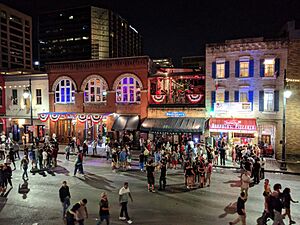
The O. Henry House Museum hosts the annual O. Henry Pun-Off, a pun contest where the successful contestants exhibit wit akin to that of the author William Sydney Porter.
Other annual events include Eeyore's Birthday Party, Spamarama, Austin Pride Festival & Parade in August, the Austin Reggae Festival in April, Kite Festival, Texas Craft Brewers Festival in September, Art City Austin in April, East Austin Studio Tour in November, and Carnaval Brasileiro in February. Sixth Street features annual festivals such as the Pecan Street Festival and Halloween night. The three-day Austin City Limits Music Festival has been held in Zilker Park every year since 2002. Every year around the end of March and the beginning of April, Austin is home to "Texas Relay Weekend."
Austin's Zilker Park Tree is a Christmas display made of lights strung from the top of a Moonlight tower in Zilker Park. The Zilker Tree is lit in December along with the "Trail of Lights," an Austin Christmas tradition. The Trail of Lights was canceled four times, first starting in 2001 and 2002 due to the September 11 Attacks, and again in 2010 and 2011 due to budget shortfalls, but the trail was turned back on for the 2012 holiday season.
From 1962 to 1998, the Austin Aqua Festival, or "Aqua Fest", took place on the shores of Town Lake (now known as Lady Bird Lake). Originally conceived as a summer tourism draw, the multi-day event evolved from water-themed activities to a broader civic festival due to growth and community interest. Eventually attendance and financial solvency began to dwindle as larger music and summer festivals grew in prominence.
Cuisine and breweries
Notable Austin cuisine includes Texas barbecue and Tex-Mex; Franklin Barbecue in Austin's has sold out of brisket every day since its establishment. Breakfast tacos and queso are popular food items in the city; Austin is sometimes called the "home of the breakfast taco." Kolaches are a common pastry in Austin bakeries due to the large Czech and German immigrant population in Texas. The Oasis Restaurant is the largest outdoor restaurant in Texas, which promotes itself as the "Sunset Capital of Texas" with its terraced views looking West over Lake Travis. Birdie's, a counter-service restaurant and wine bar that opened in 2021, was Food & Wine's 2023 Restaurant of the Year.
P. Terry's, an Austin-based fast food burger chain, has a loyal following among Austinites. Some other Austin-based chain restaurants include Amy's Ice Creams, Chuy's, DoubleDave's Pizzaworks, and Schlotzky's. The Chili's at 45th and Lamar has been the subject of internet memes since 2011.
Austin is also home to a large number of food trucks, with 1,256 food trucks operating in 2016. The city of Austin has the second-largest number of food trucks per capita in the United States. Austin's first food hall, "Fareground," features a number of Austin-based food vendors and a bar in the ground level and courtyard of One Congress Plaza.
Austin has a large craft beer scene, with over 50 microbreweries in the metro area. Drinks publication VinePair named Austin as the "top beer destination in the world" in 2019. Notable Austin-area breweries include Jester King Brewery, Live Oak Brewing Company, and Real Ale Brewing Company.
Music
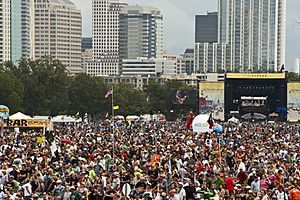
As Austin's official slogan is The Live Music Capital of the World, the city has a vibrant live music scene with more music venues per capita than any other U.S. city. Austin's music revolves around the many nightclubs on 6th Street and an annual music/film/interactive festival known as South by Southwest (SXSW). The concentration of restaurants, bars, and music venues in the city's downtown core is a major contributor to Austin's live music scene, as the ZIP Code encompassing the downtown entertainment district hosts the most bar or alcohol-serving establishments in the U.S.
The longest-running concert music program on American television, Austin City Limits, is recorded at ACL Live at The Moody Theater, located in the bottom floor of the 478 feet (146 m) W Hotels in Austin. Austin City Limits and C3 Presents produce the Austin City Limits Music Festival, an annual music and art festival held at Zilker Park in Austin. Other music events include the Urban Music Festival, Fun Fun Fun Fest, Wobeon Music Festival, Chaos In Tejas, Seismic Music Festival at the Concourse Project, and Old Settler's Music Festival. Austin Lyric Opera performs multiple operas each year (including the 2007 opening of Philip Glass's Waiting for the Barbarians, written by University of Texas at Austin alumnus J. M. Coetzee). The Austin Symphony Orchestra performs a range of classical, pop and family performances and is led by music director and conductor Peter Bay. The Austin Baroque Orchestra and La Follia Austin Baroque ensembles both give historically informed performances of Baroque music. The Texas Early Music Project regularly performs music from the Medieval and Renaissance eras, as well as the Baroque.
Film
Austin hosts several film festivals, including the SXSW (South by Southwest) Film Festival and the Austin Film Festival, which hosts international films. A movie theater chain by the name of Alamo Drafthouse Cinema was founded in Austin in 1997; the South Lamar location of which is home to the annual week-long Fantastic Fest film festival. In 2004 the city was first in MovieMaker Magazine's annual top ten cities to live and make movies.
Austin has been the location for a number of motion pictures, partly due to the influence of The University of Texas at Austin Department of Radio-Television-Film. Films produced in Austin include The Texas Chain Saw Massacre (1974), Songwriter (1984), Man of the House, Secondhand Lions, Texas Chainsaw Massacre 2, Nadine, Waking Life, Spy Kids, The Faculty, Dazed and Confused, The Guards Themselves, Wild Texas Wind, Office Space, The Life of David Gale, Miss Congeniality, Doubting Thomas, Slacker, Idiocracy, Death Proof, The New Guy, Hope Floats, The Alamo, Blank Check, The Wendall Baker Story, School of Rock, A Slipping-Down Life, A Scanner Darkly, Saturday Morning Massacre, and most recently, the Coen brothers' True Grit, Grindhouse, Machete, How to Eat Fried Worms, Bandslam and Lazer Team. In order to draw future film projects to the area, the Austin Film Society has converted several airplane hangars from the former Mueller Airport into filmmaking center Austin Studios. Projects that have used facilities at Austin Studios include music videos by The Flaming Lips and feature films such as 25th Hour and Sin City.
Austin also hosted the MTV series, The Real World: Austin in 2005. Season 4 of the AMC show Fear the Walking Dead was filmed in various locations around Austin in 2018. The film review websites Spill.com and Ain't It Cool News are based in Austin. Rooster Teeth Productions, creator of popular web series such as Red vs. Blue and RWBY, was also located in Austin.
Theater
Austin has a strong theater culture, with dozens of itinerant and resident companies producing a variety of work. A volunteer-run arts organization supporting creative expression and counter-culture community - Church of the Friendly Ghost (COTFG) helped many experimental programs get their start in Austin,TX. The city also has live performance theater venues such as the Zachary Scott Theatre Center, Vortex Repertory Company, Salvage Vanguard Theater, Rude Mechanicals' the Off Center, Austin Playhouse, Scottish Rite Children's Theater, Hyde Park Theatre, the Blue Theater, The Hideout Theatre, and Esther's Follies. The Victory Grill was a renowned venue on the Chitlin' Circuit. Public art and performances in the parks and on bridges are popular. Austin hosts the Fuse Box Festival each April featuring theater artists.
The Paramount Theatre, opened in downtown Austin in 1915, contributes to Austin's theater and film culture, showing classic films throughout the summer and hosting regional premieres for films such as Miss Congeniality. The Zilker Park Summer Musical is a long-running outdoor musical.
The Long Center for the Performing Arts is a 2,300-seat theater built partly with materials reused from the old Lester E. Palmer Auditorium.
Ballet Austin is among the fifteen largest ballet academies in the country. Each year Ballet Austin's 20-member professional company performs ballets from a wide variety of choreographers, including their artistic director, Stephen Mills. The city is also home to the Ballet East Dance Company, a modern dance ensemble, and the Tapestry Dance Company which performs a variety of dance genres.
The Austin improvisational theatre scene has several theaters: ColdTowne Theater, The Hideout Theater, The Fallout Theater, and The Institution Theater. Austin also hosts the Out of Bounds Comedy Festival, which draws comedic artists in all disciplines to Austin.
Libraries
The Austin Public Library is operated by the City of Austin and consists of the Central Library on César Chávez Street, the Austin History Center, 20 branches and the Recycled Reads bookstore and upcycling facility. The APL library system also has mobile libraries – bookmobile buses and a human-powered trike and trailer called "unbound: sin fronteras."
The Central Library, which is an anchor to the redevelopment of the former Seaholm Power Plant site and the Shoal Creek Walk, opened on October 28, 2017. The six-story Central Library contains a living rooftop garden, reading porches, an indoor reading room, bicycle parking station, large indoor and outdoor event spaces, a gift shop, an art gallery, café, and a "technology petting zoo" where visitors can play with next-generation gadgets like 3D printers. In 2018, Time magazine named the Austin Central Library on its list of "World's Greatest Places."
Museums and other points of interest
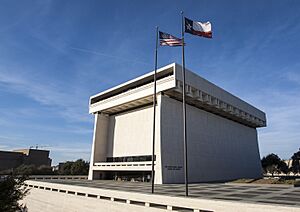
Museums in Austin include the Texas Memorial Museum, the George Washington Carver Museum and Cultural Center, Thinkery, the Blanton Museum of Art (reopened in 2006), the Bob Bullock Texas State History Museum across the street (which opened in 2000), The Contemporary Austin, the Elisabet Ney Museum, the Women and Their Work gallery, and the galleries at the Harry Ransom Center. The Texas State Capitol itself is also a major tourist attraction.
The Driskill Hotel, built in 1886, once owned by George W. Littlefield, and located at 6th and Brazos streets, was finished just before the construction of the Capitol building. Sixth Street is a musical hub for the city. The Enchanted Forest, a multi-acre outdoor music, art, and performance art space in South Austin hosts events such as fire-dancing and circus-like-acts. Austin is also home to the Lyndon Baines Johnson Library and Museum, which houses documents and artifacts related to the Johnson administration, including LBJ's limousine and a re-creation of the Oval Office.
Locally produced art is featured at the South Austin Museum of Popular Culture. The Mexic-Arte Museum is a Mexican and Mexican-American art museum founded in 1983. Austin is also home to the O. Henry House Museum, which served as the residence of O. Henry from 1893 to 1895. Farmers' markets are popular attractions, providing a variety of locally grown and often organic foods.
Austin also has many odd statues and landmarks, such as the Stevie Ray Vaughan Memorial, the Willie Nelson statue, the Mangia dinosaur, the Loca Maria lady at Taco Xpress, the Hyde Park Gym's giant flexed arm, and Daniel Johnston's Hi, How are You? Jeremiah the Innocent frog mural.
The Ann W. Richards Congress Avenue Bridge houses the world's largest urban population of Mexican free-tailed bats. Starting in March, up to 1.5 million bats take up residence inside the bridge's expansion and contraction zones as well as in long horizontal grooves running the length of the bridge's underside, an environment ideally suited for raising their young. Every evening around sunset, the bats emerge in search of insects, an exit visible on weather radar. Watching the bat emergence is an event that is popular with locals and tourists, with more than 100,000 viewers per year. The bats migrate to Mexico each winter.
The Austin Zoo, located in unincorporated western Travis County, is a rescue zoo that provides sanctuary to displaced animals from a variety of situations, including those involving neglect.
The HOPE Outdoor Gallery was a public, three-story outdoor street art project located on Baylor Street in the Clarksville neighborhood. The gallery, which consisted of the foundations of a failed multifamily development, was a constantly-evolving canvas of graffiti and murals. Also known as "Castle Hill" or simply "Graffiti Park", the site on Baylor Street was closed to the public in early January 2019 but remained intact, behind a fence and with an armed guard, in mid-March 2019. The gallery will build a new art park at Carson Creek Ranch in Southeast Austin.
Sports
| Club | Sport | Founded | League | Venue |
|---|---|---|---|---|
| Austin FC | Soccer | 2018 | Major League Soccer | Q2 Stadium |
| Austin Crows | Australian rules football | 2002 | United States Australian Football League | Onion Creek Soccer Complex |
| Austin Outlaws | Quadball | 2016 | Major League Quadball | Round Rock Multipurpose Complex |
| Austin Rise FC | Soccer | 2022 | WPSL PRO | House Park |
| Austin Sol | Ultimate | 2016 | Ultimate Frisbee Association | Parmer Field |
| Austin Spurs | Basketball | 2005 | NBA G League | H-E-B Center at Cedar Park |
| Austin Torch | Ultimate | 2019 | Premier Ultimate League | Rudolph Gamblin Field |
| Round Rock Express | Baseball | 2000 | Pacific Coast League (AAA) | Dell Diamond |
| Texas Stars | Ice hockey | 2009 | American Hockey League | H-E-B Center at Cedar Park |
Many Austinites support the athletic programs of the University of Texas at Austin known as the Texas Longhorns. During the 2005–2006 academic term, Longhorns football team was named the NCAA Division I FBS National Football Champion, and Longhorns baseball team won the College World Series. The Texas Longhorns play home games in the state's second-largest sports stadium, Darrell K Royal–Texas Memorial Stadium, seating over 101,000 fans. Baseball games are played at UFCU Disch–Falk Field.
Austin was the most populous city in the United States without a major-league professional sports team, which changed in 2021 with Austin FC's entry to MLS. Minor-league professional sports came to Austin in 1996, when the Austin Ice Bats began playing at the Travis County Expo Center; they were later replaced by the AHL Texas Stars. Austin has hosted a number of other professional teams, including the Austin Spurs of the NBA G League, the Austin Aztex of the United Soccer League, the Austin Outlaws in WFA football, and the Austin Aces in WTT tennis.
Natural features like the bicycle-friendly Texas Hill Country and generally mild climate make Austin the home of several endurance and multi-sport races and communities. The Capitol 10,000 is the largest 10 k race in Texas, and approximately fifth largest in the United States. The Austin Marathon has been run in the city every year since 1992. Additionally, the city is home to the largest 5 mile race in Texas, named the Turkey Trot as it is run annually on Thanksgiving. Started in 1991 by Thundercloud Subs, a local sandwich chain (who still sponsors the event), the event has grown to host over 20,000 runners. All proceeds are donated to Caritas of Austin, a local charity.
The Austin-founded American Swimming Association hosts several swim races around town. Austin is also the hometown of several cycling groups and the disgraced cyclist Lance Armstrong. Combining these three disciplines is a growing crop of triathlons, including the Capital of Texas Triathlon held every Memorial Day on and around Lady Bird Lake, Auditorium Shores, and Downtown Austin.
Austin is home to the Circuit of the Americas (COTA), a grade 1 Fédération Internationale de l'Automobile specification 3.427-mile (5.515 km) motor racing facility which hosts the Formula One United States Grand Prix. The State of Texas has pledged $25 million in public funds annually for 10 years to pay the sanctioning fees for the race. Built at an estimated cost of $250 to $300 million, the circuit opened in 2012 and is located just east of the Austin Bergstrom International Airport. The circuit also hosts the EchoPark Automotive Grand Prix NASCAR race in late March each year.
The summer of 2014 marked the inaugural season for World TeamTennis team Austin Aces, formerly Orange County Breakers of the southern California region. The Austin Aces played their matches at the Cedar Park Center northwest of Austin, and featured former professionals Andy Roddick and Marion Bartoli, as well as current WTA tour player Vera Zvonareva. The team left after the 2015 season.
In 2017, Precourt Sports Ventures announced a plan to move the Columbus Crew SC soccer franchise from Columbus, Ohio to Austin. Precourt negotiated an agreement with the City of Austin to build a $200 million privately funded stadium on public land at 10414 McKalla Place, following initial interest in Butler Shores Metropolitan Park and Roy G. Guerrero Colorado River Park. As part of an arrangement with the league, operational rights of Columbus Crew SC were sold in late 2018, and Austin FC was announced as Major League Soccer's 27th franchise on January 15, 2019, with the expansion team starting play in 2021.
The Austin Country Club is a private golf club located along the shores of the Colorado River, right next to the Pennybacker Bridge. Founded in 1899, the club moved to its third and present site in 1984, which features a challenging layout designed by noted course architect Pete Dye.
Austin is set to host the BLAST.TV Austin Major, the 22nd Counter-Strike Major esports tournament, from June 9 to 22, 2025.
Education
According to the 2015–2019 Census estimates, 51.7% of Austin residents aged 25 and over have earned at least a bachelor's degree, compared with the national figure of 32.1%. 19.4% hold a graduate or professional degree, compared with the national figure of 12.4%.
Higher education
Austin is home to the University of Texas at Austin, the flagship institution of the University of Texas System with over 40,000 undergraduate students and 11,000 graduate students.
Other institutions of higher learning in Austin include St. Edward's University, Huston–Tillotson University, Austin Community College, Concordia University, the Seminary of the Southwest, Texas Health and Science University, University of St. Augustine for Health Sciences, Austin Graduate School of Theology, Austin Presbyterian Theological Seminary, Virginia College's Austin Campus, The Art Institute of Austin, Southern Careers Institute of Austin, Austin Conservatory and branch campuses of Case Western Reserve University and Park University.
The University of Texas System and Texas State University System are headquartered in downtown Austin.
Public primary and secondary education
Approximately half of the city by area is served by the Austin Independent School District. This district includes notable schools such as the magnet Liberal Arts and Science Academy High School of Austin, Texas (LASA), which, by test scores, has consistently been within the top thirty high schools in the nation, as well as The Ann Richards School for Young Women Leaders. The remaining portion of Austin is served by adjoining school districts, including Round Rock ISD, Pflugerville ISD, Leander ISD, Manor ISD, Del Valle ISD, Lake Travis ISD, Hays ISD, and Eanes ISD.
Private and alternative education
The Austin metropolitan area is also served by 27 charter school districts and over 100 private schools. Austin has a large network of private and alternative education institutions for children in PreK–12th grade exists. Austin is also home to several child developmental institutions.
Media
Austin's main daily newspaper is the Austin American-Statesman. The Austin Chronicle is Austin's alternative weekly, while The Daily Texan is the student newspaper of the University of Texas at Austin. Austin's business newspaper is the weekly Austin Business Journal. The Austin Monitor is an online outlet that specializes in insider reporting on City Hall, Travis County Commissioners Court, AISD, and other related local civics beats. The Monitor is backed by the nonprofit Capital of Texas Media Foundation. Austin also has numerous smaller special interest or sub-regional newspapers such as the Oak Hill Gazette, Westlake Picayune, Hill Country News, Round Rock Leader, NOKOA, and The Villager among others. Texas Monthly, a major regional magazine, is also headquartered in Austin. The Texas Observer, a muckraking biweekly political magazine, has been based in Austin for over five decades. The weekly Community Impact Newspaper published by John Garrett, former publisher of the Austin Business Journal has five regional editions and is delivered to every house and business within certain ZIP codes and all of the news is specific to those ZIP codes. Another statewide publication based in Austin is The Texas Tribune, an on-line publication focused on Texas politics. The Tribune is "user-supported" through donations, a business model similar to public radio. The editor is Evan Smith, former editor of Texas Monthly. Smith co-founded the Texas Tribune, a nonprofit, non-partisan public media organization, with Austin venture capitalist John Thornton and veteran journalist Ross Ramsey.
Commercial radio stations include KASE-FM (country), KVET (sports), KVET-FM (country), KKMJ-FM (adult contemporary), KLBJ (talk), KLBJ-FM (classic rock), KJFK (variety hits), KFMK (contemporary Christian), KOKE-FM (progressive country) and KPEZ (rhythmic contemporary). KUT-FM is the leading public radio station in Texas and produces the majority of its content locally. KOOP (FM) is a volunteer-run radio station with more than 60 locally produced programs. KVRX is the student-run college radio station of the University of Texas at Austin with a focus on local and non-mainstream music and community programming. Other listener-supported stations include KAZI (urban contemporary), and KMFA (classical).
Network television stations (affiliations in parentheses) include KTBC (Fox O&O), KVUE (ABC), KXAN (NBC), KEYE-TV (CBS), KLRU (PBS), KNVA (The CW), KBVO (MyNetworkTV), and KAKW (Univision O&O). KLRU produces several award-winning locally produced programs such as Austin City Limits. Despite Austin's explosive growth, it is only a medium-sized market (currently 38th) because the suburban and rural areas are not much larger than the city proper. Additionally, the proximity of San Antonio truncates the potential market area.
Alex Jones, journalist, radio show host and filmmaker, produces his talk show The Alex Jones Show in Austin which broadcasts nationally on more than 60 AM and FM radio stations in the United States, WWCR Radio shortwave and XM Radio: Channel 166.
Notable people
International relations
Austin has two types of relationships with other cities, sister and friendship.
Sister cities
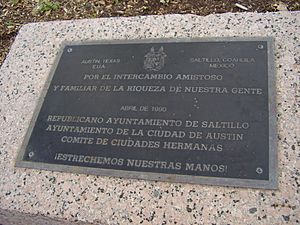
Austin's sister cities are:
 Adelaide, South Australia, Australia (1983)
Adelaide, South Australia, Australia (1983) Angers, Pays de la Loire, France (2011)
Angers, Pays de la Loire, France (2011) Antalya, Antalya Province, Turkey (2009)
Antalya, Antalya Province, Turkey (2009) Gwangmyeong, Gyeonggi-do, South Korea (2001)
Gwangmyeong, Gyeonggi-do, South Korea (2001) Hackney, London, England, United Kingdom (2014)
Hackney, London, England, United Kingdom (2014) Koblenz, Rhineland-Palatinate, Germany (1991)
Koblenz, Rhineland-Palatinate, Germany (1991) Lima, Peru (1981)
Lima, Peru (1981) Maseru, Lesotho (1978)
Maseru, Lesotho (1978) Ōita, Ōita, Japan (1990)
Ōita, Ōita, Japan (1990) Pune, Maharashtra, India (2018)
Pune, Maharashtra, India (2018) Saltillo, Coahuila, Mexico (1968)
Saltillo, Coahuila, Mexico (1968) Taichung, Taiwan (1986)
Taichung, Taiwan (1986) Xishuangbanna, Yunnan, China (1997)
Xishuangbanna, Yunnan, China (1997)
The cities of Belo Horizonte, Brazil and Elche, Spain were formerly sister cities, but after an Austin City Council vote in 1991, their statuses were deactivated. Orlu, South East, Nigeria became a sister city in 2000, but was downgraded to emeritus status later.
Friendship cities
Covenants between two city leaders:
 Siem Reap, Cambodia (2011)
Siem Reap, Cambodia (2011) Villefranche-sur-Mer, France (2010)
Villefranche-sur-Mer, France (2010) Tehuacán, Puebla, Mexico (2019)
Tehuacán, Puebla, Mexico (2019) San Luis Potosí, San Luis Potosí, Mexico (2024)
San Luis Potosí, San Luis Potosí, Mexico (2024) Chiang Mai, Thailand (2023)
Chiang Mai, Thailand (2023)
See also
 In Spanish: Austin para niños
In Spanish: Austin para niños












